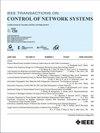Consensus Protocol-Based Reachable Nodes in the Controllability of Directed Graphs
IF 4
3区 计算机科学
Q2 AUTOMATION & CONTROL SYSTEMS
引用次数: 0
Abstract
In this article, we discuss the controllability of reachable nodes in directed graphs over consensus protocol. A node is called a reachable node if there is a path from an input to this node, otherwise unreachable node. The rows in the controllability matrix associated with unreachable nodes are shown to be zero rows, and a prerequisite for controllability is that all nodes are reachable. A method for constructing controllable directed graphs is provided later in this article. If the in-degrees of all nodes are distinct, and there are neither sibling nodes nor unreachable nodes, the system is controllable. A subsystem composed of reachable nodes is called a reachable subsystem. All reachable nodes are proved to be controllable if and only if the reachable subsystem is controllable. For a reachable subsystem with a tree graph, a necessary and sufficient condition for controllability is given. Besides, if the reachable subsystem with a tree graph is uncontrollable, a graphical method is given to identify the dimension of controllable subspace.有向图可控性中基于可到达节点的共识协议
本文章由计算机程序翻译,如有差异,请以英文原文为准。
求助全文
约1分钟内获得全文
求助全文
来源期刊

IEEE Transactions on Control of Network Systems
Mathematics-Control and Optimization
CiteScore
7.80
自引率
7.10%
发文量
169
期刊介绍:
The IEEE Transactions on Control of Network Systems is committed to the timely publication of high-impact papers at the intersection of control systems and network science. In particular, the journal addresses research on the analysis, design and implementation of networked control systems, as well as control over networks. Relevant work includes the full spectrum from basic research on control systems to the design of engineering solutions for automatic control of, and over, networks. The topics covered by this journal include: Coordinated control and estimation over networks, Control and computation over sensor networks, Control under communication constraints, Control and performance analysis issues that arise in the dynamics of networks used in application areas such as communications, computers, transportation, manufacturing, Web ranking and aggregation, social networks, biology, power systems, economics, Synchronization of activities across a controlled network, Stability analysis of controlled networks, Analysis of networks as hybrid dynamical systems.
 求助内容:
求助内容: 应助结果提醒方式:
应助结果提醒方式:


